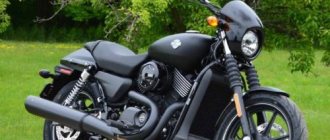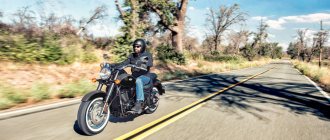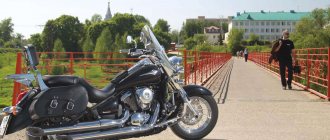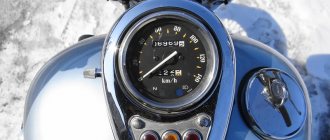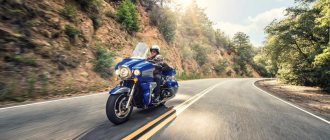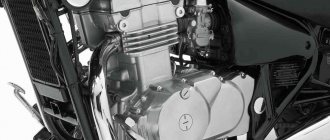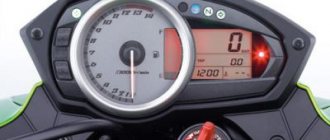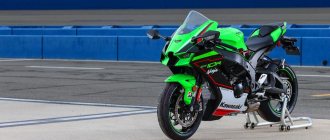Cruisers are the motorcycles that experienced bikers choose for long trips. Cruisers have become popular among motorcyclists not so long ago. This class of motorcycles has won the hearts of motorcyclists because it is designed for long trips with maximum comfort. When creating cruisers, manufacturers primarily strive for the convenience of riding a bike. Greater power and maneuverability play a lesser role here, but this does not mean that such motorcycles have poor acceleration dynamics. An example of a real cruiser is the Kawasaki Vulcan 900, which will be discussed in our review.
History of the Kawasaki Vulcan motorcycle
The Japanese company Kawasaki launched production of the Vulcan back in 1984. The first motorcycle models quickly began to fill the roads of Japan, then Europe, and soon the whole world. This model gained fans who actively watched all the developments and innovations among the Vulcan series motorcycles. The very first motorcycle was a cruising chopper with an engine capacity of 700 cm3 and producing 41 hp. At that time, manufacturers could not afford to produce motorcycles with a larger engine due to customs duties, since if the engine exceeds 750 cm3, the import cost almost doubled. When import restrictions were lifted, the Japanese company Kawasaki began to actively develop and produce models with an engine capacity of 900, then 1500 and in 2004 – 2000 cm3! The most powerful engine produced 116 hp. At that time, these were incredible figures for two-wheeled vehicles.
The Kawasaki Vulcan lineup includes 9 models. The last two are the Kawasaki Vulcan 900 and Vulcan 1700. Each model was created with the purpose of operating it on long trips. Although the company tried to produce more powerful engines, comfort and pleasant appearance still remained a priority.
Brief history of the model
2006 - start of production and sales of Kawasaki VN900 Vulcan Classic and Kawasaki VN900 Vulcan Classic LT. The model is only available on the American market. Maximum power is 50 hp, maximum torque is 82 Nm. Model: Kawasaki Vulcan 900 Classic, Kawasaki Vulcan 900 Classic LT. Factory designation: VN900B6F, VN900D6F.
2007 - appearance of the Kawasaki VN900 Vulcan Custom modification. The model, in addition to the American market, is available in Europe, Japan and other countries. Model: Kawasaki Vulcan 900 Classic, Kawasaki Vulcan 900 Classic LT, Kawasaki Vulcan 900 Custom. Factory designation: VN900B7F, VN900D7F, VN900C7F.
2008 - no significant changes. Model: Kawasaki Vulcan 900 Classic, Kawasaki Vulcan 900 Classic LT, Kawasaki Vulcan 900 Custom. Factory designation: VN900B8F, VN900D8F, VN900C8F.
2009 - model not available in the Japanese market. Model: Kawasaki Vulcan 900 Classic, Kawasaki Vulcan 900 Classic LT, Kawasaki Vulcan 900 Custom. Factory designation: VN900B9F, VN900D9F, VN900C9F.
2010 - model again available in Japan. Model: Kawasaki Vulcan 900 Classic, Kawasaki Vulcan 900 Classic LT, Kawasaki Vulcan 900 Custom. Factory designation: VN900BAF, VN900DAF, VN900CAF.
2011 - no significant changes. Model: Kawasaki Vulcan 900 Classic, Kawasaki Vulcan 900 Classic LT, Kawasaki Vulcan 900 Custom. Factory designation: VN900BBF, VN900DBF, VN900CBF.
2012 - no significant changes. Model: Kawasaki Vulcan 900 Classic, Kawasaki Vulcan 900 Classic LT, Kawasaki Vulcan 900 Custom. Factory designation: VN900BCF, VN900DCF, VN900CCF.
2013 - changes in environmental emission standards. Kawasaki VN900 Vulcan produces 48 hp. power and 78 Nm of torque. Model: Kawasaki Vulcan 900 Classic, Kawasaki Vulcan 900 Classic LT, Kawasaki Vulcan 900 Custom. Factory designation: VN900BDF, VN900DDF, VN900CDF.
2014 - no significant changes. Model: Kawasaki Vulcan 900 Classic, Kawasaki Vulcan 900 Classic LT, Kawasaki Vulcan 900 Custom. Factory designation: VN900BEF, VN900DEF, VN900CEF.
2015 - no significant changes. Model: Kawasaki Vulcan 900 Classic, Kawasaki Vulcan 900 Classic LT, Kawasaki Vulcan 900 Custom. Factory designation: VN900BFF, VN900DFF, VN900CFF.
2016 - no significant changes. Model: Kawasaki Vulcan 900 Classic, Kawasaki Vulcan 900 Classic LT, Kawasaki Vulcan 900 Custom. Factory designation: VN900BGF, VN900DGF, VN900CGF.
2017 - no significant changes. Model: Kawasaki Vulcan 900 Classic, Kawasaki Vulcan 900 Classic LT, Kawasaki Vulcan 900 Custom. Factory designation: VN900BHF, VN900DHF, VN900CHF.
2018 - no significant changes. Model: Kawasaki Vulcan 900 Classic, Kawasaki Vulcan 900 Classic LT, Kawasaki Vulcan 900 Custom (North America, Australia). Factory designation: VN900BJF, VN900DJF, VN900CJF.
2019 - no significant changes. Model: Kawasaki Vulcan 900 Classic, Kawasaki Vulcan 900 Classic LT, Kawasaki Vulcan 900 Custom (North America, Australia). Factory designation: VN900BKF, VN900DKF, VN900CKF.
2020 - no significant changes. Model: Kawasaki Vulcan 900 Classic, Kawasaki Vulcan 900 Classic LT, Kawasaki Vulcan 900 Custom (North America, Australia). Factory designation: VN900BLF, VN900DLF, VN900CLF.
2021 - no significant changes. Model: Kawasaki Vulcan 900 Classic, Kawasaki Vulcan 900 Classic LT, Kawasaki Vulcan 900 Custom (North America, Australia). Factory designation: VN900BMFAN, VN900DMFNN, VN900CMFAN / VN900CMFAL.
Kawasaki Vulcan 900 – stylish and tasteful
The appearance of the Kawasaki 900 is the first thing that catches your eye. First of all, the bike is very big. The huge engine gives you an idea of how powerful this bike is. Wide wheels give you confidence in good grip and safety when cornering. Also not to be missed is the powerful front fork, which provides comfort when riding on uneven roads. Secondly, despite all the bulkiness and voluminous shape of the motorcycle, the manufacturer was able to add small details that logically complete the appearance of the motorcycle. The turn signals and rear brake light are located very well. And the monotonous color is diluted by chrome inserts. The Kawasaki 900 motorcycle is made simply and tastefully. There is nothing superfluous in its exterior that could distract you during your trip. But at the same time, everything is in its place - which is why the motorcycle gives only positive emotions.
Kawasaki Vulcan lineup
The Vulcan series of motorcycles from the Japanese company Kawasaki has four models of “volcanoes”:
- Classic
- Classic LT
- Custom
- Classic Special Edition
Each of the models is unique in its own way, so when purchasing, you can choose the option that suits you best. Let's start in order.
Kawasaki VN Classic is the simplest configuration. The classic version has spoked wheels with a radius of 16 on the front wheel, and with a radius of 15 on the rear. The engine covers and the exhaust system are chrome-plated. You also get a regular shaped loveseat.
Kawasaki VN Custom. In this version, instead of a 16-radius wheel, you get 21-diameter wheels. The rear wheel remains exactly the same for better traction. The motorcycle's legs are equipped with additional unique rubber bands, and the motorcycle uses much less chrome surfaces.
Kawasaki VN Classic Light Tourer is an expanded version of the regular “classic”. In the Light Tourer you additionally get a windshield, rear seat backrest and side saddlebags made from genuine leather.
Kawasaki VN Classic Special Edition is a series of motorcycles presented in a limited number of units. The appearance is represented by a unique graphic design. In addition, wire wheel spokes are installed, which is also quite rare on motorcycles of this class.
Hi all. And again, friends, I decided to share with you my impressions and experience of operating a motorcycle. This time we will talk about a motorcycle, which is the direct opposite of sportbikes and extreme riding. As I wrote earlier, the 2013 season was not super successful for me, since the 636th kava went missing and attempts to find it were unsuccessful. From time to time I tried to suppress motor toxicosis with a pit bike, but still this was absolutely not enough. And then one fine day a friend (also a motorcyclist) calls me and tells me great news: “Bro, I’m flying away on vacation with my family, do you want to ride a chopper?” As you understand, my answer did not take long to arrive.
And so there are 14 days ahead and Kawasaki VN 900 Custom.
I will try to describe in as much detail as possible all the pros and cons of this model and share my impressions. Let's start with the appearance of the volcano. As you know, Kawasaki produces the Vulcan in two versions: Classik and Custom. There are no fundamental differences in design, but the appearance is noticeably different. First, let's look at both versions of the Custom, characterized by: • matte black color with a thin green or red flat running along the tank, • black rims with green (red) edging, • front wheel of increased diameter, • straight steering wheel. The classic version looks more traditional and, I would even say, is suitable for an older audience. Everything here is maintained in the best chopper traditions: • Chrome-plated spoked wheels • On the side there are two sparkling chrome-plated exhaust pipes • Chrome-plated engine covers • Large curved steering wheel Having figured out how the two main versions of the 900 cc Vulcan differ, let’s begin to deal with this motorcycle in order. In my review I will talk about the Custom version. The price of a motorcycle at that time was somewhere in the region of 420-450 thousand (I don’t remember exactly) for a new one, and a quite decent used one could be found in the region of 350-370 thousand, which in principle was acceptable and played an important role in buying this motorcycle, a novice lover of choppers... Let's start with the appearance. In my opinion, the volcano looks very good, the only thing is that it is a little small for a chopper. It will not be possible to put it on a par with the same Harley sportster, for example, since it claims to be in a large weight category, and it clearly does not reach the level of large, massive models. Why I mentioned Harley is because, probably, any person associates the class of choppers primarily with Harleys. They can be criticized, scolded or, on the contrary, praised, but the trendsetters in this segment are Harley Davidson motorcycles and all Japanese analogues on a subconscious level and not only compared with them. However, if you don’t find fault and look with the eyes of an inexperienced person, and most of the people who buy 900 Vulcans are just such people, then the motorcycle looks very nice. Moreover, both versions are classic and so-called Custom. The choice here, I repeat, is determined solely by subjective preferences. There are no complaints about the assembly, everything is screwed together efficiently and firmly. The seat is wide, soft, the footrests are moved forward, in general, the style is 100% respected. The dashboard is more than ascetic; there is only a speedometer to indicate the fuel level, and lamps for neutral, high beam and turn signals. On the one hand, you can complain about the lack of a tachometer and gear indicator, but on the other hand, on such a motorcycle the lack of a tachometer is not critical (after all, it’s not a sport bike), and you get used to it quite quickly. As for such little things as mirrors, grips, brake and clutch handles, gear shift paws, all owners have huge potential for tuning and realizing their fantasies. All this was done quite simply without any frills, but in my opinion this is even for the better, since it is possible to individualize the equipment. The mufflers are located on the side and look very good; on the Custom version they are painted matte black, but here they clearly ask for some kind of tuning analogue. In general, in appearance, probably everything. All that remains is to see if there are any glove compartments or panniers. The standard equipment does not spoil us with this, but if there is a need, there are a lot of beautiful ready-made solutions on the market. Having sorted out the appearance, let's say a few words about the technology. From a technical point of view, the motorcycle is simple and reliable. There cannot be two opinions here. The engine is a 900 cc V-shaped two-wheeler that has been used for years and produces a modest 48 hp. at 5700 rpm and 77 Nm of torque at 3700 rpm. The motorcycle is liquid cooled and does not have any problems with overheating, unlike its more famous competitors. It’s stupid to talk about any outstanding characteristics, and that’s not the main thing in this motorcycle. Having driven it a little, I can confidently say one thing: if you select the gears wisely and don’t overclock the engine, you can handle Moscow traffic quite comfortably without feeling handicapped. The maximum speed is around 150, but it’s comfortable to drive 110-130 maximum. The box works well, neutral is caught without problems, there are no complaints here, it might be nice to have one more gear (the Vulcan has a 5-speed gearbox) to slightly increase the maximum speed. The main drive is driven by a belt. This can only be considered a plus. No need to think about chain maintenance: cleaning, lubrication, and fairly frequent replacement. The design of the suspension is quite simple, but it is quite enough. There are 41mm telescopic forks at the front and a Uni-Trak shock absorber with 7-position spring preload adjustment at the rear. On the move, the suspension feels quite soft. Small bumps and irregularities are easily swallowed and do not cause discomfort. I think there is no point in talking about sharp handling, but overall the bike steers pretty well. Compared to heavy Harleys like the Street Glide, the Vulcan is just a bike. And to be completely honest, when it comes to handling, and we all immediately express our expert opinion, often pointing out that this or that motorcycle has problems with handling, I want to immediately turn on the well-known videos of motorcycle gymkhana, where Not all participating motorcycles are the pinnacle of technology. So we consider the handling of the volcano to be quite acceptable for this class. He will never become a sports biker or a road worker (street fighter) or a sports tourist anyway, and there is no such task. Now that I’ve learned, let’s say, the theory, I’ll tell you a little about my feelings from operation. Considering that I switched to this miracle of technology from a modern sports bike, the first kilometers of the journey, when I was driving towards home, were full of completely new sensations for me. Everything made me uncomfortable and stressed me out. I couldn’t relax, I didn’t understand how it steered, how sharply I could brake and how quickly I could accelerate. Having made the route from the proletarka towards Prospekt Mira, getting stuck in a traffic jam near Kurskaya, the realization slowly began to dawn on me that I could ride this too. The wide steering wheel in a traffic jam seemed to me not such an obstacle - I began to manage to maneuver. After driving a little more, I began to get used to the gearbox and engine. For the first few kilometers I was constantly hitting the cut-off point, or driving somewhere close to it, holding off gear. Then, when I started working more actively with the gearbox (like on a diesel engine), at some point it even seemed to me that driving could be quite exciting and fun. It’s generally great to start from traffic lights; due to the long wheelbase, you can unscrew it all the way without fear of rearing up. And there is enough time to start sharply, the main thing is to switch competently. Regarding the factor of attracting attention, there are no particular problems with this either. The motik attracts attention, although the audience is 30+)))). Many grown men roll down their windows and ask the standard questions “how much does he eat”, “how much does he eat”. The fair sex, of course, will not be very shocking with such a motorcycle, although as they say, every product has its own buyer)))). In a word, the Kawasaki VN900 Custom turned out to be a very successful motorcycle in its price category. What we haven't been able to come to terms with is the brakes. In my opinion, they are not enough. I partly explain this by the fact that I switched from sports, but on the other hand, the motorcycle stops really hard, so you have to press the lever with almost your whole hand to brake. Conclusion: The Kawasaki VN900 Custom is an excellent choice for a beginner chopper. If you really like this class of motorcycles, then you can buy a good quality Japanese device for little money (in relation to 2013). There are not many alternatives to it. The motorcycle is easy to maintain, reliable, and fuel-efficient. It will be quite easy to choose a used one, since usually “speed racers” do not fly on such motorcycles and do not spin them at breakneck speeds. It is also quite liquid on the secondary market, given its low cost and good quality. Problems begin only with very old copies imported from abroad and having a bunch of pitfalls. Considering this bike as a long-distance bike, I would think a thousand times about riding it far. Although there are few vibrations, they are there; on a long journey they will be felt very well. In my opinion, the power reserve is a little small, because if you have to overtake a truck that will go 100 km/h even in a headwind, it can be a little uncomfortable. But this is my personal opinion. We all know that there are examples of travelers even on sports, and they are quite happy. To sum it up, we’ll say an excellent motorcycle for a beginner, a motorcyclist who likes this class of motorcycles, and also suitable for practical people who value a high price-quality ratio. If you want to show off, then you need to look at Harleys! PS Dear friends, I hope the review was useful. Read, comment, subscribe. If you have questions or I forgot to write something, ask, I will be happy to answer. Good luck to everyone, smooth roads, more motorcycles, fewer fools on the roads!
Vulcan 900 Specifications
The Kawasaki Vulcan 900 custom motorcycle is equipped with a four-stroke V-twin engine with a total power of 53 hp. For high-quality cooling of the power unit, a liquid cooling system was installed on the motorcycle, which does its job quite well. By the way, the motorcycle engine can only be started using electronic ignition, since the engine is not equipped with a kickstarter.
Regardless of the version of the Kawasaki Vulcan, we get a 5-speed gearbox that we would like to highlight. It’s amazing how smooth and easy gear shifting the manufacturers were able to achieve. If you carefully monitor the technical condition of the transmission and change the oil exactly on time, then the box should last a very long time. Separately, it is worth mentioning the numbers. The maximum acceleration speed of the Kawasaki Vulcan 900 custom is 180 km/h, which is a decent result for a cruiser. But still, there’s probably no point in riding this bike at such a speed, because first of all, the motorcycle was created for comfortable travel over long distances. By the way, the Kawasaki Vulcan 900 can be called a fairly economical motorcycle, since approximately 5 liters of gasoline are consumed per 100 km. However, it is worth remembering that it all depends on your driving style and the type of road surface.
